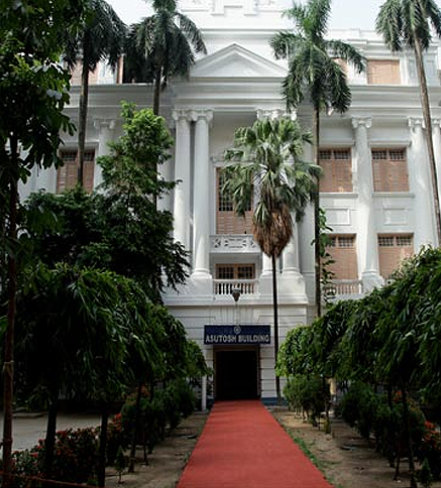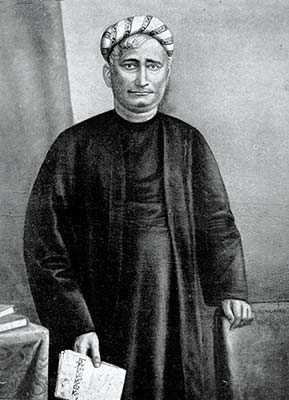
Bankimchandra Chatterjee
Bankimchandra Chatterjee (1838-1894) was born in the village of Kanthalpara in the district of 24-Parganas on 27
June, 1838. Bankimchandra was one of the two students of the first B.A. batch of the University of Calcutta.
Following in his father's footsteps, Bankimchandra joined the Subordinate Executive Service and became a deputy
magistrate and deputy collector. As an officer of the colonial government, he did his job well, and, in recognition
of his service, received the titles of Rai Bahadur in 1891 and Companion of the Most Eminent Order of the Indian
Empire (CMEOIE) in 1894. Though Bankimchandra gained from his career the necessary experience, he made a place for
himself in history not as an executive officer but as a writer and an intellectual.
While a deputy magistrate at Baruipur in the district of 24-Parganas, Bankimchandra wrote his first two
celebrated novels: Durgeshnandini (1865) and Kapalkundala (1866). Others followed in quick succession, till, by
1887, all fourteen of Bankim's novels had been published, along with other prose works. Anandamath (1882) is
possibly Bankim's last notable literary work. Anandamath (The Mission House of Felicity, 1882) is a political novel.
The novel also contains the song "Vande Mataram" (Hail the Mother) which was set to music by Rabindranath Tagore.
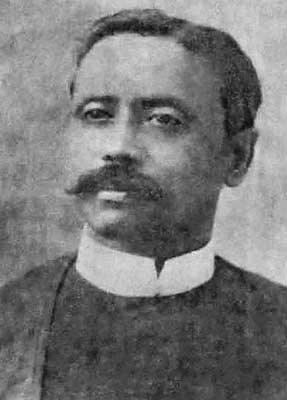
Nabinchandra Sen
Nabinchandra Sen (1847-1909), poet, was born in Noapara village in Chittagong (in modern-day Bangladesh) on 10 February, 1847. He passed the Entrance examination (1863) from Chittagong School, F.A. (1865) from Presidency College in Calcutta and B.A. (1868) from General Assembly, Calcutta. He taught briefly at Hare School in Calcutta before joining government service as deputy magistrate. He retired in 1904.
Nabinchandra started writing poems while still a student. His poems used to be published in the Education Gazette edited by Peary Charan Sarkar. His first volume of poems was published in 1871. His poem Palashir Yuddha, published in 1875, made him instantly famous. His other major publications are the epics Raivatak (1887), Kuruksetra (1893) and Prabhas (1896). The hero of these epics is Krishna. Though best known as an epic poet in the tradition of Michael Madhusudan Dutt, Nabinchandra wrote many remarkable lyrics and narrative poems, marked by a sense of nationalism.
Nabinchandra's other books include his autobiography, Amar Jiban, and the biographies on Khrister Jibani (The Life of Christ) and Cleopatra. Though Amar Jiban is an autobiography it reads like a novel. It also documents contemporary society, politics and administration. His other well-known books include Bhanumati and Prabaser Patra. He also did a verse translation of the Bhagavad Gita and Chandi.

Chandramukhi Basu
Chandramukhi Basu (1860 - 1944) was one of the first two female graduates of the British Empire . Along with Kadambini Ganguli, she received her Bachelor's degree in Arts from the Bethune College, an affiliated college of the University of Calcutta, in 1883.
The daughter of Bhuban Mohan Bose, she passed the First Arts examination from Dehradun Native Christian School in 1880. Till then Bethune School did not admit non-Hindu girls. The rule was relaxed and she was admitted for the degree course, along with Kadambini Ganguli.
After her graduation, she was the only and first woman to pass M.A. from the University of Calcutta in 1884.
She started her career as a lecturer in Bethune College (it was still part of Bethune School) in 1886.
The college was separated from the school in 1888. She became the Principal, thus becoming the first female head of an undergraduate
academic establishment in South Asia. She retired in 1891 because of bad health and spent the rest of her life in Dehradun
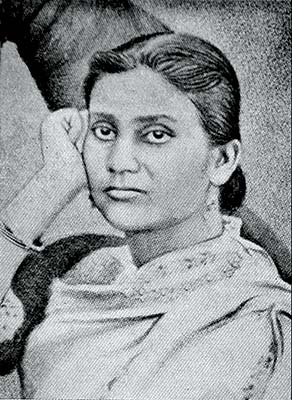
Kadambini Ganguli
Kadambini Ganguli (1861-1923) was one of the first female graduates of the British Empire and the first female physician of South Asia to be trained in European medicine.The daughter of Brahmo reformer Braja Kishore Basu, she was born at Bhagalpur, Bihar in British India. The family was from Chandsi, in Barisal which is now in Bangladesh. Her father was headmaster of Bhagalpur School. He and Abhay Charan Mallick started the movement for women's emancipation at Bhagalpur, establishing the women's organisation, Bhagalpur Mahila Samiti in 1863, the first in India.
Kadambini started her education at Banga Mahila Vidyalaya and while at Bethune School in 1878 became the first woman to pass the University of Calcutta entrance examination. It was partly in recognition of her efforts that Bethune College first introduced F.A. (First Arts), and then graduation courses in 1883. She and Chandramukhi Basu became the first graduates from Bethune College, and in the process became the first female graduates in the country and in the entire British Empire.Ganguli studied medicine at the Calcutta Medical College. In 1886, she was awarded a GBMC (Graduate of Bengal Medical College) degree, which gave her the right to practise. She thus became the first Indian woman doctor qualified to practice western medicine.
In 1883, she married the Brahmo reformer and leader of women's emancipation Dwarka Nath Ganguli. They were actively involved in female emancipation and social movements to improve work conditions of female coal miners in eastern India. She was one of the six female delegates to the fifth session of the Indian National Congress in 1889, and even organised the Women's Conference in Calcutta in 1906 in the aftermath of the partition of Bengal. In 1908, she had also organised and presided over a Calcutta meeting for expressing sympathy with Satyagraha - inspired Indian labourers in Transvaal, South Africa. She formed an association to collect money with the help of fundraisers to assist the workers. In 1914, she presided over the meeting of the Sadharan Brahmo Samaj, which was held in Calcutta to honour Mahatma Gandhi during his visit to Calcutta.

Praphullachandra Ray
Praphullachandra Ray (1861-1944), scientist, educationist and nationalist visionary was born on 2 August, 1861. After his childhood education in his village school, Praphullachandra moved to Calcutta and passed the Entrance Examination from the University of Calcutta in 1878. He joined the Metropolitan Institution (now renamed Vidyasagar College), from where he passed the First Arts Examination in 1880. In 1882, he joined the University of Edinburgh where he obtained the B.Sc. degree in 1885 and D.Sc. degree in Chemistry in 1887. Praphullachandra then entered the Bengal Education Service and joined the Presidency College Calcutta, as a temporary Assistant Professor of Chemistry in 1889.
In 1902, Praphullachandra published his famed History of Hindu Chemistry, which came out in a revised and enlarged form in 1904. The immense popularity of the book led him to stretch it to a second volume, published in 1909. As a scientist Praphullachandra was particularly esteemed among his peers for his seminal contributions to mercurous nitrites preparation. In 1912, the University of Durham conferred on him the Honorary Degree of D.Sc. in recognition of his contributions to scientific investigations. The British Government first honoured him with the imperial title of CIE (Companion of the Indian Empire); and then with the Knighthood in 1919. In 1916 Praphullachandra left the Presidency College and joined the newly founded Calcutta University College of Science as a Professor of Chemistry. In 1920, he was elected General President of the Indian Science Congress. The Universities of Calcutta, Benaras and Dhaka successively conferred on him the Honorary D.Sc. Degrees in recognition of his contributions to the development of science. In 1932, the first volume of his autobiography, Life and Experiences of a Bengali Chemist, was published, and a second volume in 1935. Apart from being a path-breaking scientist he was an intense nationalist. He implored his countrymen to set up new enterprises. He himself set an example by establishing the Bengal Chemical & Pharmaceutical Works (1901), one of the pioneering ventures of its kind.
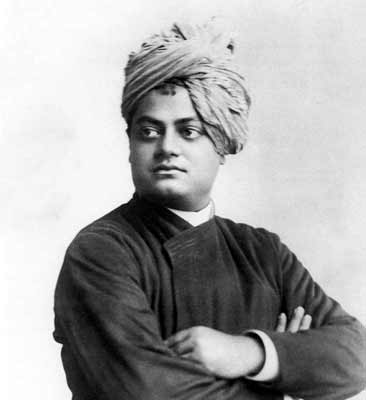
Narendranath Dutta
(Swami Vivekananda)
Narendranath Dutta (1863-1902) was born in Shimla Pally, Calcutta. In 1879, he entered the Presidency College, Calcutta for higher studies. After one year, he joined the Scottish Church College, Calcutta and studied philosophy. During the course, he studied western logic, western philosophy and history of European nations and was due to appear in his Law examination in 1886, but his father's sudden death brought an abrupt end to his academic career. In 1882, Narendranath came into contact with Sri Ramakrishna of Dakshineswar. The spiritual transformation of Narendranath at the hands of Sri Ramakrishna began in 1882 and was completed with his realisation of the oneness of all existence in 1886.
After Sri Ramakrishna's death in August 1886, he organised his brotherhood into a monastic order and went on a pilgrimage throughout India. At the conclusion of the pilgrimage he sat in meditation on the last rock of India (since known as 'Vivekananda Shila') at Kanyakumari. In September 1893, at the Conference of Religions at Chicago, he presented the supreme truth of Vedanta. He stayed on in the West from 1893 to 1896 to preach that the essence of religion lay in the divinity of man.
Narendranath’s spiritual conquest of the West won him several western disciples, including Margaret Noble, later known as Sister Nivedita. In May 1897, he founded the Ramakrishna Mission. In 1898, he founded Belur Math, a place that eventually became the headquarters of the worldwide Ramakrishna Movement.

Asutosh Mookerjee
Asutosh Mookerjee (1864-1924), educationist, jurist, a judge of the Calcutta High Court and Vice-Chancellor of the University of Calcutta was born on 29 June, 1864 in Bhawanipur, Calcutta. He was throughout a brilliant student.
In 1906, he became the Vice-Chancellor of the University and served in that capacity till 1914. During this period his first task was to finalise the new regulations. His primary emphasis was to introduce postgraduate courses in different disciplines and in order to make this plan a success, he mobilised resources from various quarters. He inducted some finest talents for different departments. He upheld the autonomy of the University at great personal cost.
He was appointed Vice-Chancellor once again in 1921. Even in the fading years of his life there was still enough fire left in him and he crossed sword with the government on the issue of autonomy. He turned down the conditional offer of reappointment with these words " I send you without hesitation the only answer which you and your advisers expect and desire : I decline the insulting offer you have made to me".

Ramendrasundar Trivedi
Ramendrasundar Trivedi (1864-1919), essayist, educationist and scientist, was born on 20 August, 1864 in the village of Teya in Murshidabad, West Bengal. He passed the Entrance Examination from Kandi English School in 1882. He obtained the second place in F.A. from Presidency College in 1884, and stood first in both B.A. Honours in Physics and Chemistry in the year 1886, and M.A. in Physics in 1887. He was awarded the Premchand Roychand Studentship in 1888. Trivedi joined Ripon College as a Professor of Science in 1892 and was appointed the Principal of that college in 1903, a position that he held until his death.
He began his literary career with articles published in the magazines Sadhana, Nabajiban and Bharati. He took initiative in establishing Bangiya Sahitya Parishad (1894), and was elected president in 1919. He edited the journal of the Parisad, Bangiya Sahitya Parisad Patrika, for two terms, from 1899-1903, and again from 1917-18. Trivedi had extensive knowledge of linguistics, eastern and western philosophy, science, the Vedas, folklore, etc. He had the ability to articulate complicated theories of science and philosophy in a very lucid language. His writings manifest his liberal thinking and literary wit. His major literary works include Prakriti Jijnasa (1903, a compilation of articles on philosophy), Karmakatha (1913), Charitakatha (1913), Bichitra Jagat (1913), Shabdakatha (1917), etc.

Brajendranath Seal
Brajendranath Seal (1864-1938), philosopher, was born on 3 September, 1864, at Calcutta. After completing his B.A. at Calcutta's General Assembly's Institution (later to be known as Scottish Church College) he became a lecturer there. In 1884, he obtained his M.A. degree in Mental and Moral Philosophy, standing first in first class. In 1910, he got his Ph.D. degree from the University of Calcutta for his thesis on 'Mechanical, Physical and Chemical Theories of Ancient Hindus'.
Brajendranath taught at a number of colleges and also served as a Principal. He was the first Indian Principal at Coachbihar Victoria College (subsequently renamed Acharya Brajendranath Seal College). He served as the Professor of Philosophy at the University of Calcutta from 1912 to 1921. From 1921 to 1930 he was the Vice-Chancellor of Mysore University. He also held the King George V Chair of Mental and Moral Science at the University of Calcutta (later named the Brajendranath Seal Chair of Mental and Moral Science).
Brajendranath was one of the greatest scholars of his time and was addressed as 'Acharya'. He was also known as a "moving university" for his encyclopaedic knowledge. Brajendranath Seal mastered many branches of learning. His essays contain profound discourse on art, literature, culture, civilization, anthropology, sociology, and philosophy. His best-known works are A Memoir on the Co-efficient of Numbers; A Chapter on the Theory of Numbers (1891); Neo-Romantic Movement in Bengali Literature (1890-91); A Comparative Study of Christianity and Vaishnavism (1899),etc. He received an honorary D.Sc. from the University of Calcutta.
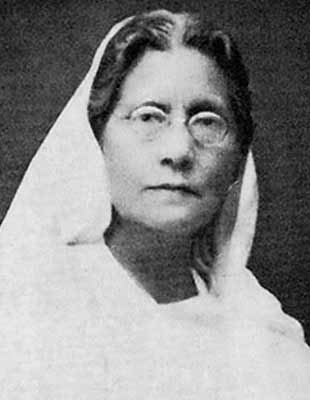
Kamini Roy
Kamini Roy (1864-1933) was a leading Bengali poet, social worker and feminist. She was the first woman honours graduate in India.
Born on 12 October, 1864 in the village of Basanda, then in Bakergunj district of East Bengal and now in Barisal District of Bangladesh, she passed the entrance examination in 1880 from Bethune School, Calcutta and F.A. in 1883. She obtained her B.A. degree with Sanskrit honours from Bethune College of the University of Calcutta in 1886. Kadambini Ganguli was three years senior to her in the same institution. She continued her association with Bethune College as a teacher.
She was inclined towards literature from a young age and started composing poems at the age of eight. Her first book of poems, Alo O Chhaya, was published in 1889. Amongst her notable literary contributions were –Mahasweta, Pundorik, Pouraniki, Dwip O Dhup, Jibon Pathey, Nirmalya, Malya O Nirmalya, and Ashok Sangeet. She wrote Gunjan for children and a book of essays Balika Sikkhar Adarsha.

Dineschandra Sen
Dineschandra Sen (1866-1939), a pioneer in recovering the rich treasure of folk songs, ballads and literature of Bengal and builder of the department of Bengali Language and Literature of the University of Calcutta, was born in the village of Bogjuri in the district of Manikgani (now in Bangladesh). He started teaching at a school in Sylhet. While working in the ••••school, Sen passed his B.A. examination with honours in English in 1889 as a private student. He then moved to Comilla , taking a job at Victoria School.
It was at this time that Dineschandra turned into an enthusiastic collector of the surviving fragments of Bengal's past. He moved from village to village collecting old Bangla manuscripts, folk songs, folk myths and legends and folk language and ballads, realising that, unless collected, these treasures would soon perish and disappear forever. Based on his empirical research, he published his first monumental work entitled Banga Bhasa O Sahitya (Bengali Language and Literature), the first comprehensive and scientific study by any Bengali scholar so far. This work fetched him instant recognition as a scholar of rare ability.
Dineschandra Sen wrote and edited about 55 books in Bengali and twelve books in English in addition to a large number of research articles published in various learned journals. Apart from Banga Bhasa O Sahitya, his works include Ramayani Katha (Tales of Ramayana), 1904; Behula (a folk tale), 1907; Vaidik Bharat (Vedic India: based on stories from the Vedas), 1922; Pauraniki (Tales from the Puranas), 1934; and Brihat Banga (Greater Bengal: a social history) in two volumes, 1935. His major English works include History of Bengali Language and Literature (1911), Sati (1916), The Vaishnava Literature of Medieval Bengal (1917), The Folk-Literature of Bengal (1920), Bengali Prose Style, Chaitanya and His Age (1922), Eastern Bengal Ballads of Mymensingh in four volumes (1923-1932) and Glimpses of Bengal Life (1925).
In 1909, he was appointed reader in the Department of Bengali Language and Literature of the University of Calcutta and was entrusted with the responsibility of building and developing the new faculty. He was made Ramtanu Lahiri Professor in 1913. University of Calcutta conferred on him the degree of Doctor of Literature in recognition of his work in 1921 and Jagattarini Gold Medal in 1931.

Jadunath Sarkar
Jadunath Sarkar (1870-1958) was born in Natore (in modern-day Bangladesh) on 10 December, 1870. He graduated with honours in English and History in 1891 and stood first in M.A. in English in 1892 from the University of Calcutta. He got the Premchand Roychand Studentship in 1897, and his essay, India of Aurangzeb was published in 1901.
The historical works of Jadunath can be divided into two broad types. In the first category were his major works, such as History of Aurangzeb (5 Vols, 1912-1958), Shivaji and His Times (1919), Mughal Administration (1920), Fall of the Mughal Empire (4 Vols, 1932-38), Military History of India, etc. The other category included all his translations into English and Bengali of the Persian and Marathi documents as well as innumerable articles in English and Bengali, reviews, forewords, etc. His published Bengali articles numbered 148, much less than his English articles which numbered 365. He was Vice-Chancellor of the University of Calcutta from 1926 to 1928.
Jadunath is remembered for his outstanding historical scholarship. His Aurangzeb and Shivaji narrated the history of the seventeenth century around two individuals while his Fall of the Mughal Empire dealt with the crisis of the Empire in the eighteenth century. His grasp over details, meticulous scholarship and superb literary style elevate him to the status of one of the greatest historians of India.

Upendranath Brahmachari
Upendranath Brahmachari (1873 -1946) was born in Jamalpur, Bihar. He took his B.A. degree from Hooghly Mohsin College with honours in Mathematics and Chemistry. Thereafter he went to study Medicine with Higher Chemistry. He took his Master’s degree in 1894 from Presidency College, Calcutta. He took his M.B. degree in 1900 standing first in Medicine and in Surgery. He obtained his M.D. in 1902, and was awarded Ph.D. in 1904 for his research paper on “Studies in Haemolysis”.
Upendranath joined the Provincial Medical Service in 1899 and appointed a teacher of Pathology and Materia medica, and physician in the Dacca Medical School in 1901. In 1905, he was appointed a teacher in Medicine and Physician at the Campbell Medical School, Calcutta, where he carried out most of his work on Kala-azar and made his monumental discovery of Urea Stibamine. He retired from the Govt. Service as a physician in the Medical College Hospital. He was a nominee for the Nobel prize in 1929 in the category of physiology and medicine. He was president of the 23rd session of the Indian Science Congress in 1936.

Bidhan Chandra Roy
Bidhan Chandra Roy (1882-1962), the physician and politician, was born on 1 July, 1882 at Bankipur in Patna. A brilliant student, Roy passed Entrance examination from Patna Collegiate School in 1897 and F.A.examination from Patna College in 1899. In 1901, he joined Calcutta Medical College. He obtained M.S.S. degree from the University of Calcutta in 1906. In 1942, Bidhan Chandra Roy became the Vice-Chancellor of the University of Calcutta and held the post till March, 1944.

Rajendra Prasad
Rajendra Prasad was born in 1884. He studied at Presidency College, Calcutta and was a boarder of the Eden Hindu Hostel. He obtained a degree of Law from the University of Calcutta. An ardent nationalist and a veteran freedom fighter, he was elected President of the Indian National Congress during its Bombay session in 1934. He again became its President when Subhas Chandra Bose resigned in 1939. He served as the President of the Constituent Assembly that drafted the Constitution of India.
After India became independent he was elected the President of India. In 1962, after 12 years as President, he announced his decision to retire. He was subsequently awarded the Bharat Ratna, the nation's highest civilian award. Because of the enormous public adulation he enjoyed, he was referred to as Desh Ratna or the Jewel of the country. He wrote a number of books including Satyagrah at Champaran, Bapu ke kadmon mein, India divided and Atmakatha.

Sukumar Roy
Sukumar Roy (1887-1923), a maestro in children’s literature, was born in Kolkata in 1887. His father, Upendra Kishore Roychowdhury, who also wrote for children, was a musician and mechanic and his son was the Oscar-winning filmmaker Satyajit Roy.
After passing the Entrance examination from the City School, Sukumar Roy took his B.Sc. in Chemistry from Presidency College in the year 1911. He then went to England on the Guruprasanna Ghosh Scholarship to study photography and printing technology. Sukumar studied at the Manchester School of Technology, where he proved the effectiveness of photo printing in halftone invented by his father. He was selected fellow of the Royal Photographic Society. He was the second Indian to earn this distinction. Back home in 1913, he took over his father's enterprise called U Roy and Sons.
Sukumar Roy was a versatile genius. He used to compose rhymes at an early age. While studying at Presidency College, he set up an organisation called 'Nonsense Club'. On his return from England, he started the 'Monday Club' where he used to arrange discussions along with refreshments, which earned the club another name, Monda (Bangla for sweetmeat) Club.
Sukumar Roy was principally noted for his writings for young children. He mixed comic elements and subtle satire in all his works : poems, plays, stories or paintings. His satire is marked by his social consciousness. His prominent writings include Abol-Tabol (Nonsensical Mnemonics, 1923), Ha-Ja-Ba-Ra-La (Topsy-Turvy, 1928), Pagla Dashu (1940), Bahurupi (The Jester, 1944), Khaikhai (I Want More, 1950), Abak Jalpan (Strange Drink), Shabdakalpadrum (The Tree of Words) and Jhalapala (Irritation). He also wrote some serious essays in Bengali and English. He wrote a collection of belles-lettres called Hesoramer Dairi, written in the form of a diary.
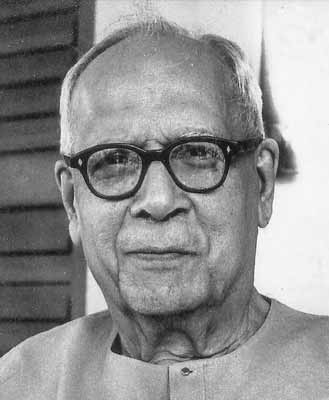
Rameschandra Majumdar
Rameschandra Majumdar (1888-1980), a doyen of Bengali historians, was born at Khandarpara in Faridpur district. He graduated with honours in History in 1909 from Presidency College and obtained M.A. degree from the University of Calcutta in 1911. In 1912, he was awarded Premchand Roychand Studentship. He started his career in 1913 in Dacca Teachers' Training College. In July 1914, he was appointed a lecturer in the History department of University of Calcutta. In 1919, the University of Calcutta published Majumdar's Ph.D. thesis, Corporate Life in Ancient India. In July 1921, he joined the newly established Dacca (Dhaka) University as Professor of History.
While in Dhaka, Majumdar planned a comprehensive history of Bengal. The first was edited by him, with the ancient period, and the second was edited by Sir Jadunath Sarkar, with the medieval period. Dhaka University published the two volumes. These were widely acclaimed by scholars all over the world as the first comprehensive work on the ancient period of the history of Bengal. In 1936, Majumdar became the Vice-Chancellor of the Dacca University and held the post till the middle of 1942.
The Bharatiya Vidya Bhavana series under the general title History and Culture of the Indian People in eleven massive volumes was the most important achievement of Majumdar. In 1950, he joined the Benaras Hindu University as the founder-principal of the College of Indology, and stayed there till 1953, adopting various measures for its improvement. In 1950, Majumdar was elected a member and Vice-President for the 'International Commission for a History of the Scientific and Cultural Development of Mankind'.
Majumdar's difference with the Government of India over the "History of the Freedom Movement" Project led him to write four massive volumes - The Sepoy Mutiny and the Revolt of 1857 (one volume, 1957) and History of the Freedom Movement in India (three volumes, 1962-63). In 1955, Majumdar became the founder-principal of the College of Indology of Nagpur University. In 1958-59, he taught Indian history in the Universities of Chicago and Pennsylvania. Together with Hemchandra Raychaudhuri and Kalikinkar Datta he wrote Advanced History of India, a authentic book on Indian history written for undergraduates. He delivered many endowment lectures in different universities of India and was recipient of numerous awards from various academic institutions.
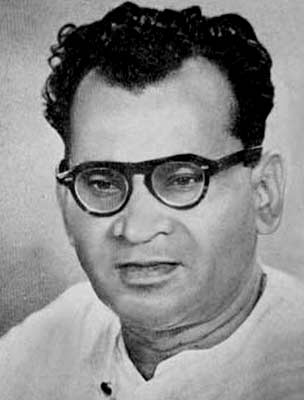
Sunitikumar Chatterji
Sunitikumar Chatterji (1890-1977), linguist, educationist and litterateur, was born on 26 October, 1890 at Shivpur in Howrah. Sunitikumar was a meritorious student, and passed the Entrance examination in 1907 from Motilal Free School, ranking sixth, and the F.A. from Scottish Church College, standing third. In London, he studied Phonology, Indo-European Linguistics, Prakrit, Persian, old Irish, Gothic and other languages. He then went to Paris and did research at the Sorbonne in Indo-Aryan, Slav and Indo-European Linguistics, Greek and Latin. Returning to India in 1922, he joined the University of Calcutta as a Professor. After retirement he was made Professor Emeritus and, in 1963, National Professor.
Sunitikumar accompanied Rabindranath Tagore to Malaya, Sumatra, Java, and Bali, where he delivered lectures on Indian art and culture. He was Speaker of the West Bengal Assembly from 1952-1958 and President of the Sahitya Academy (1969).
Among his important publications on both language and literature are the origin and development of the Bengali language, Bengali Phonetic Reader, Bangla Bhasatattver Bhumika (Introduction to Bengali Linguistics), Bharater Bhasa O Bhasa Samasya (Languages and Language Problem of India), Jati Sangskriti Sahitya (Nation, Culture, Literature), Sangskrti Ki (What is Culture), Rabindra Sangame (Towards Unity with Raindranath), Pashchimer Yatri (Traveller to the West), Europe Bhraman (Travels in Europe), Dvipamay Bharat (India of Many Islands), etc. He was awarded the title of Bhasacharya by Rabindranath Tagore, Sahitya Vachaspati (1948) by Allahabad Hindi Literary Conference and Padma Vibhushan (1948) by the Government of India
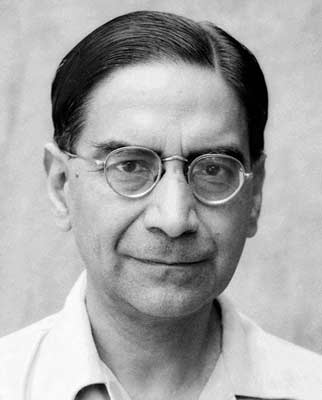
Prasantachandra Mahalanobis
Prasantachandra Mahalanobis (1893-1972) was an Indian scientist and applied statistician. He graduated in Physics in 1912 from Presidency College, Calcutta and completed Tripos at King's College, Cambridge. He then returned to Calcutta. He is best known for the Mahalanobis distance, a statistical measure. He did pioneering work on anthropometric variation in India. He founded the Indian Statistical Institute on 17 December, 1931 and contributed to large-scale sample surveys.
In later life, he contributed prominently to newly independent India's five-year plans starting from the second. His variant of Wassily Leontief's Input-output model was employed in the second and later plans to work towards rapid industrialisation of India and with his colleagues at his Institute, he played a key role in developing the required statistical infrastructure.
He received one of the highest civilian awards Padma Vibhushan from the Government of India for his contribution to science and services to the country. He died on June 28, 1972, a day before his seventy-ninth birthday. Even at this age, he was still active doing research work and discharging his duties as the Secretary and Director of the Indian Statistical Institute and as the Honorary Statistical Advisor to the Cabinet of the Government of India.

Meghnad Saha
Meghnad Saha (1893-1956) was an astrophysicist. He was born on 6 October, 1893 in Dhaka. He studied at Dhaka Collegiate School, and later at Dhaka College. He was a student at Presidency College, Calcutta ; a Professor at Allahabad University from 1923 to 1938 and thereafter a Professor and Dean of the Faculty of Science at the University of Calcutta until his death in 1956. He became Fellow of the Royal Society in 1927. He was president of the 21st session of the Indian Science Congress in 1934.
He invented an instrument to measure the weight and pressure of solar rays. He produced the famous equation which he called 'equation of the reaction - isobar for ionisation' which later became known as Saha's "Thermo-Ionisation Equation", or the Saha Equation.
Meghnad Saha's basic work was on the Thermal ionisation of elements and it led him to formulate what is known as the Saha equation. Saha's equation is one of the basic tools for interpretation of the spectra of stars in astrophysics. By studying the spectra of various stars, one can find their temperature and from that, using Saha's equation, determine the ionisation state of the various elements in the star. He was also associated with building several scientific institutions like the Physics Department in Allahabad University and the Institute of Nuclear Physics in Calcutta. He founded the journal, Science and Culture and was its editor till his death.
Saha was the leading spirit in organising the scientific societies and institutions like the 'National Academy of Science' (1930), the 'Indian Physical Society' (1934), 'Indian Institute of Science' (1935) and the 'Indian Association for the Cultivation of Science' (1944). The lasting memorial to him is the Saha Institute of Nuclear Physics founded in 1943 in Kolkata. He was the chief architect of river planning in India. He prepared the original plan for Damodar Valley Project.
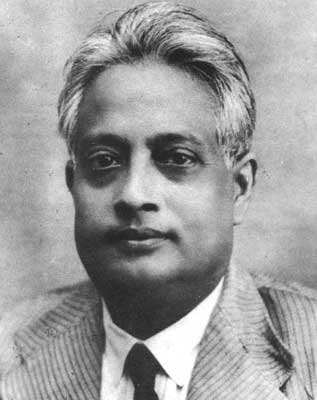
Satyendranath Bose
Satyendranath Bose (1894-1974), the physicist, specially known for his theory of quantum statistics, a pioneer of practicing science in Bengal, was born in Calcutta on 1 January, 1894. He passed the I.Sc. in 1911 from Presidency College, Calcutta securing the first position. Satyendranath obtained the B.Sc.degree in Mathematics in 1913 and M.Sc. degree in Mixed Mathematics in 1915 from Presidency College. After completing the M.Sc. degree from Presidency College, Bose paid his full attention to research on Mixed Mathematics and Physics under the fellowship with Meghnad Saha at Science College. Bose joined the newly established Dhaka University in 1921 as a Reader in the Department of Physics and later became the head of the department. While at Dhaka University, Bose worked hard in establishing the department and sincerely performed research work for twenty years at a stretch. His research on Theoretical Physics and X-ray Crystallography made him a celebrity worldwide. In 1924, Bose published his celebrated article entitled 'Planck’s Law and the Light Quantum Hypothesis'. The great physicist Albert Einstein praised the article and translated it into German. He also made proper arrangements to focus the hypothesis to the scientists through publishing it in science journals. The hypothesis received a great attention and was highly appreciated by the scientists. It became famous to the scientists as 'Bose-Einstein Theory'. One kind of particle in atom has been named after his name as 'Boson'. Bose placed his name in the history of science by solving some of the complex mathematical equations of the theory of relativity.
In 1929, Satyendranath Bose was elected Chairman of Physics of the Indian Science Congress and in 1944 elected Chairman of the Congress. He became Professor of Physics of the University of Calcutta in 1945. He also served as Khaira Professor and Dean of the Postgraduate Science Faculty. He was appointed Professor Emeritus of the University in 1958. In 1956, Professor Bose was made Vice-Chancellor of Visva-Bharati University and served there till 1958. The Government of India appointed him National Professor in 1959.
Professor Bose was a fellow of the Royal Society of London in 1958. He was nominated a member of the Rajya Sabha (Parliament) in 1952. Satyendranath Bose played a pioneering role in popularising science in Bengali language. With a view to upholding this object Professor Bose established 'Bangiya Bijnan Parisad' in Calcutta and published its organ entitled Jnan O Bijnan'. He was awarded 'Deshikottom' by Visva-Bharati University and 'Padma Bhusan' by the Indian Government in appreciation of his outstanding achievements
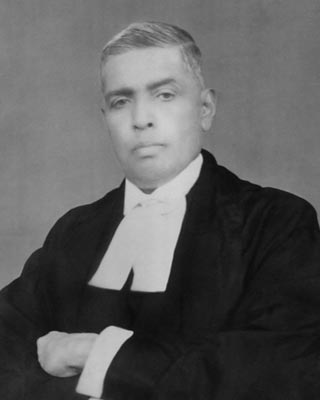
Radhabinod Pal
Radhabinod Pal (1896-1967) was born in Salimpur, Nadia. He studied mathematics and constitutional law at Presidency College, Calcutta and the Law College of the University of Calcutta.
Radhabinod Pal was the only Indian member to be appointed in the International Military Tribunal for the Far East's trials of Japanese war crimes committed during the Second World War.
In 1944, he became the Vice-Chancellor of the University of Calcutta and served in that capacity till 1946.
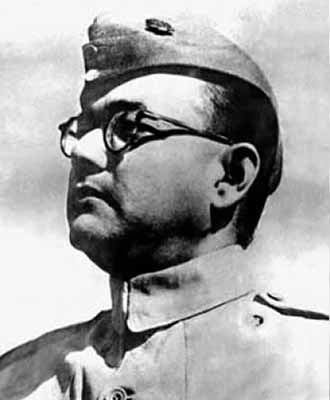
Subhas Chandra Bose
Subhas Chandra Bose was born in Cuttack in 1897. He had his education first at the Ravenshaw Collegiate School,
Cuttack and then at Scottish Church College, Calcutta where he was admitted to his B.A. course after his expulsion from Presidency College. He graduated from the University of Calcutta.
An uncompromising patriot and an ardent nationalist, Bose played a seminal role in the nationalist politics.
He was the Chief Executive Officer and later Mayor of Calcutta Corporation. He was elected President of the Indian National Congress at the Haripura Session. He was elected President again in 1939 at the Tripuri Congress but had to step down in the face of a stiff opposition from Gandhi and his loyalists. Thereafter, he formed the All India Forward Block and continued his fight against British imperialism. At the outset of the Second World War, in a daring act of escape from the eyes of the colonial police, he fled from India and reached Germany where he sought to enlist the support of the Axis powers with cause of Indian independence. Later, after the fall of Singapore, he reached there and with the help of Japan, reinvigorated the Indian National Army which consisted primarily of the Indian prisoners of war. He is immortalised in Indian history for having formed the Azad Hind Government in exile and launching armed attack against the British from the North Eastern parts of India. A true patriot in the best sense of the term, he is endearingly called Netaji.
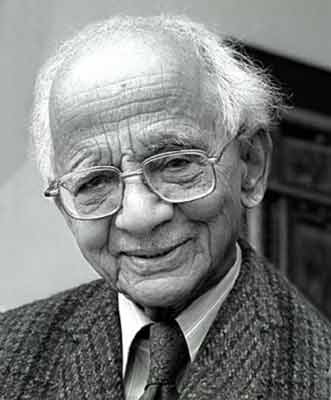
Nirad C. Chaudhuri
Nirad C. Chaudhuri (1897-1999) was a celebrated Indian writer. He was born in Kishorganj, in the then Mymensingh district of East Bengal. He was educated in Kishorganj and Calcutta. In his F.A. course he attended Ripon College (at present Surendranath College). He attended Scottish Church College, Calcutta, graduating with honours in History. He topped the University of Calcutta merit list obtaining a first class first.
He started his career as a clerk in the Accounting Department of the Indian Army. At the same time, he started contributing articles to popular magazines. He left the job in the Accounting Department shortly thereafter, living the life of intellectual journalist and editor. He was involved with the editing of the then well-known English and Bengali magazines Modern Review, Probasi (Bengali) and Sonibarer Chithi (Bengali). He himself ran two short-lived highly esteemed Bengali magazines Samasamayik and Notun Patrika.
Side by side his career as a secretary he continued contributing articles in Bengali and English to newspapers and magazines. He was also appointed as a political commentator in All India Radio - Calcutta branch. In 1941, he started working for the Delhi Branch of All India Radio.
He was a productive and prolific writer till the very end; publishing his last work at the age of 99. Some of his widely acclaimed works include : Autobiography of an Unknown Indian, A Passage to England, Thy Hand, Great Anarch , The Continent of Circe, The East is East and West is West, etc.

Jibanananda Das
Jibanananda Das (1899-1954 ) was born in Barisal (in modern-day Bangladesh). Jibanananda was educated at Barisal B.M. College and Presidency College, Calcutta. From Presidency College he completed the Master’s Degree in English. He then worked as a lecturer of English in City College in Calcutta. Jibanananda is among the most prominent modernist poets of Bengali literature. His introduction of modernism to Bengali poetry was coeval with its advent in the West. He is best known for his celebration of the natural beauty and the rural life of Bengal, although his work is shot through with an acute awareness of the evanescence of the soul, of death and the inevitability of decay. His poems have a lyrical beauty that has very few parallels in Bengali literature.
The second major theme in his poems is humanism and love. There are many poems of love, of women and of nature. Many of these poems are included in the anthology "Banalata Sen" which is now the most popular of his poetry books. He also wrote fifty volumes of diaries, and only small parts of them have been published up to 2006. Jibanananda was an active observer of politics though he never joined any group. He took part in political rallies organised by the major political parties to try to understand which way the country was headed after Independence
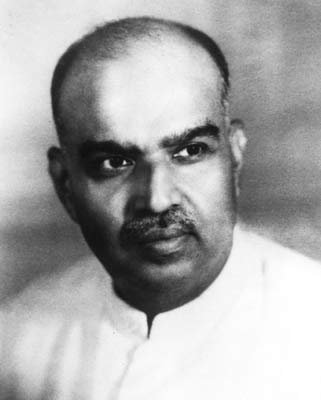
Syamaprasad Mookerjee
Syamaprasad Mookerjee (1901-1953) was born in Calcutta. His father was Sir Asutosh Mookerjee. He obtained his degree from the University of Calcutta. He became a fellow of the Senate in 1923. He enrolled as an advocate in Calcutta High Court in 1924 after his father's death. Subsequently he left for England in 1926 to study in Lincoln's Inn and became a barrister in 1927. At the age of 33, he became the youngest Vice-Chancellor of the University of Calcutta, and held the office from 1934 to 1938.
He was elected as member of the Legislative Council of Bengal. Jawaharlal Nehru inducted him in the Interim Government as a Minister for Industry and Supply. He was widely respected by many Indians and also by members of the Indian National Congress, and Sardar Vallabhbhai Patel, one of its chief leaders.
But on issue of the 1949 Delhi Pact with Pakistani Prime Minister Liaqat Ali Khan, Shyamaprasad Mookerjee resigned from the Cabinet on April 6, 1950. He founded the Bharatiya Jana Sangh on October 21, 1951 at Delhi and became its first President. He died in 1953.
***(Compiled and written by Dr. Soumitra Sarkar, University Librarian, University of Calcutta) This compilation owes a lot to Wikipedia, the free encyclopedia and Banglapedia for factual details. Despite our efforts we have not been able to trace all the copyright holders. We welcome communications from them, so that appropriate acknowledgements can be made in future.***
